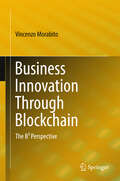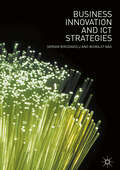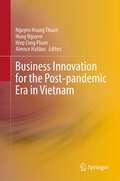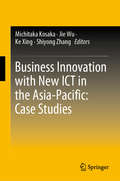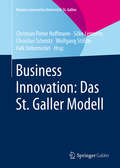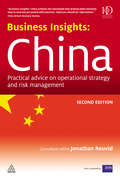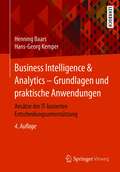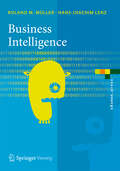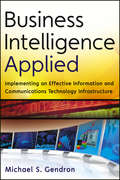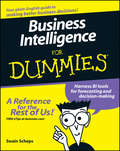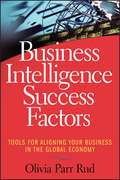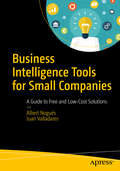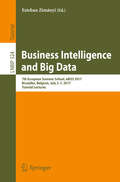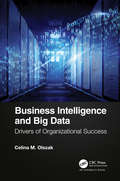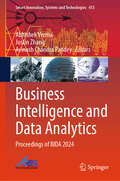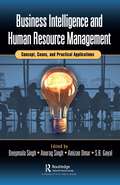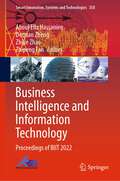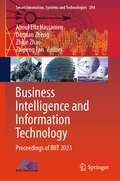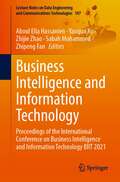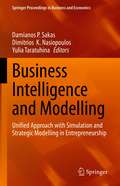- Table View
- List View
Business Innovation Through Blockchain: The B³ Perspective
by Vincenzo MorabitoThis book explores the main challenges and trends related to the use of blockchain technology for digital business innovation with the aim of providing practitioners with stimulating insights and ideas. Readers will find a unified survey of current scientific work on blockchain and related phenomena, such as bitcoin, from a range of perspectives, including information systems, technology management, innovation research, computer science, and engineering. In this way, the book links research and industry practices suitable for use by practitioners in their day-to-day activities and also provides an update on what academia may offer in terms of industry proposals. The contents are divided into three parts. After discussion of blockchain technology and management, including impacts on value chains and systems, governance, and security issues, the bitcoin phenomenon and main technological trends in the use of blockchain are addressed. The final part presents examples of business innovationusing blockchain that are drawn from across the globe. Throughout, the author adopts a methodologically rigorous approach while ensuring that the text is readily understandable for readers, regardless of their degree of acquaintance with blockchain.
Business Innovation and ICT Strategies
by Sriram Birudavolu Biswajit NagThis book investigates the real process of unleashing the power of Information and Communications Technology (ICT) through Open Innovation and strategic choices. It covers the most important aspects of ICT in a nutshell and details the road to the future through business innovation. ICT, of which telecom and IT constitute the core, is currently permeating and transforming every sphere of life, ranging from commerce, manufacturing, education and healthcare, to agriculture, banking, governance, media and entertainment. Today, telecommunication and ICT, in general, are essential to a country’s economic development and competitiveness as recognized both by the World Bank and the Asian Development Bank. Due to the powerful, disruptive and rapid forces unleashed by ICT tsunami, organisations not only struggle to harness the potential of ICT but can also be overwhelmed by the changes, complexity, competition and regulatory environment it brings up.This book provides a clue to organisations on how to sustain and succeed by leveraging ICT in absence of extensive in-house expertise across the breadth and depth of these areas. The driving theme of the book is about opening up organizational and business models, by presenting an integrated roadmap to a future with ICT, by co-opting, cooperating and competing with other organisations. Constructing the right strategy and building the necessary social capital for open innovation through collaboration with partners, government, academia and users (Quadruple Helix Model) are essential steps in such a process.
Business Innovation for the Post-pandemic Era in Vietnam
by Hung Nguyen Nguyen Hoang Thuan Hiep Cong Pham Alrence HalibasThis book documents the recent post-pandemic era business innovation research in Vietnam bringing together selected works from the 2022 ‘International Conference on Business Innovation: Business Innovation in a Post-pandemic World’ held at RMIT University in Vietnam. The book contributes to the body of knowledge in several ways. It serves as a comprehensive reference for business innovation research and promotes recent progress in business innovation applications in Vietnam and offers a shared understanding to help coordinate future research in the field.
Business Innovation in Asia: Knowledge and Technology Networks from Japan (Routledge Contemporary Asia Series)
by Dennis McNamaraIndustrial competition with rising economies, new regional investment from the West, and trade pacts among competitors threaten Japan’s long postwar prominence. Global market dynamics and regional competition prompted the shift from offshore factories to local networks in the last decade. Similar forces are driving the recent formation of regional Nikkei - Japan-affiliated - nodes in major industrial clusters in Asia. The central concept of this volume, "knowledge networks," refers to interactive linkages around nodes of tacit and codified knowledge embedded in Global Value Chains. Through survey evidence and interviews at firms and factories this book reveals the problems facing knowledge transfer, such as persisting difficulties in communication, technology transfer, and indigenous learning in regional nodes of Nikkei Value Chains and the persistence of earlier patterns of hierarchical coordination in information flows despite the shift towards more horizontal network organization. However, a comparison of Nikkei knowledge networks in China, South Korea, and Thailand reveals the possibilities of an interactive learning community in cross-border investment. If Japan can meet the challenge of tapping Asia’s offshore resources for innovation, it will pose a formidable global challenge to Western competitors.
Business Innovation with New ICT in the Asia-Pacific: Case Studies
by Ke Xing Shiyong Zhang Jie Wu Michitaka KosakaThis book clarifies the direction of business innovation using new ICT such as the Internet of things (IoT), artificial intelligence (AI), smartphones, and cloud computing through a series of case studies on successful trials and advanced businesses in the Asia-Pacific where many industry sectors have been growing successfully in the 21st century. ICT has been playing an important role in value creation for customers and in profit generation for providers, contributing to various service innovation and business innovation. Now, digitalization using IoT and AI provides solutions to address various issues in the human society, which is transforming services and businesses in the 21st century. “What is the direction of the business innovation using new ICT?” is a highly concerned question for business researchers and practitioners. Aiming to answer the question, this book conducts a number of cases studies in the Asia-Pacific region, including the Mainland China, Taiwan, Japan, Malaysia, Vietnam, as well as Australia. Among the studies, there are 4 cases from ICT providers, 4 cases from traditional and services, and 6 cases from new ICT applications and businesses. Each case analyzes social needs and human desires, new value created, roles of new technologies, processes and difficulties in developing new businesses, the relationship among customers, providers, and stakeholders, value chain co-creation and optimization, factors of success, and business models. Finally, the direction of business innovation with new ICT in the Asia-Pacific is suggested by summarizing the findings from the case studies through the lens of the theoretical analysis in service science.
Business Innovation: A Case Study Approach
by Vijay PandiarajanThis book provides an understanding of innovation models and why they are important in the business context, and considers sources of innovation and how to apply business frameworks using real-world examples of innovation-led businesses. After providing a solid background to the key concepts related to innovation models, the book looks at why innovation takes place and where the sources of innovation lie, from corporate research to crowd-sourced and government-funded initiatives. Innovation models across manufacturing, services and government are explored, as well as measuring innovation, and the impact of design thinking and lean enterprise principles on innovation and sustainability-driven imperatives. Offering a truly comprehensive and global approach, Business Innovation should be core or recommended reading for advanced undergraduate, postgraduate, MBA and Executive Education students studying Innovation Management, Strategic Management and Entrepreneurship.
Business Innovation: A Case Study Approach
by Vijay PandiarajanThis book provides an understanding of innovation models and why they are important in the business context, and considers sources of innovation and how to apply business frameworks using real-world examples of innovation-led businesses. After providing a solid background to the key concepts related to innovation models, the book looks at why innovation takes place and where the sources of innovation lie, from corporate research to crowd-sourced and government-funded initiatives. Innovation models across manufacturing, services and government are explored, as well as measuring innovation, and the impact of design thinking and lean enterprise principles on innovation and sustainability-driven imperatives.Offering a truly comprehensive and global approach, Business Innovation should be core or recommended reading for advanced undergraduate, postgraduate, MBA and Executive Education students studying Innovation Management, Strategic Management and Entrepreneurship.
Business Innovation: Das St. Galler Modell (Business Innovation Universität St. Gallen)
by Falk Uebernickel Wolfgang Stölzle Christian Pieter Hoffmann Silke Lennerts Christian SchmitzBusiness Innovation ist eine umfassende strategische Führungsaufgabe. Sie prägt das Unternehmen - und erfordert ein professionelles Management. Dieser für Praxis und Lehre konzipierte Band stellt erstmals ein ganzheitliches Modell der Business Innovation vor und beschreibt detailliert Elemente sowie Gestaltungsmöglichkeiten aus Sicht der Unternehmensführung. Aktuelle Ergebnisse der Innovationsforschung werden von ausgewiesenen Experten präsentiert, erklärt und in das Modell eingeordnet. So wird deutlich: Business Innovation ist kein Zufall, sie kann gezielt gefördert und realisiert werden.
Business Insights: China
by Jonathan ReuvidIncreasingly open to foreign investment and with a burgeoning consumer market, China represents an enormous commercial opportunity - but how can businesses succeed? Business Insights: China gives you an overview of the corporate business achievements already made in China and a comprehensive guide to the opportunities available for other businesses, wherever they are in the world. Based on the real-life experiences of, and lessons learned by, companies who have moved into the Chinese business arena, the book highlights the successes and failures of operating in such a challenging market. With practical advice and many comprehensive case studies, Business Insights: China offers invaluable assistance for anyone looking to initiate or develop their business activities in China. From the consultant editor of Managing Business Risk (also published by Kogan Page) this second edition of Business Insights: China includes a significant focus on risk management, providing a detailed examination of the unique challenges facing anyone establishing or developing a business in one of the world's most dynamic markets.
Business Intelligence
by Stacia Misner Elizabeth Vitt Michael Luckevich"This readable, practical book helps business people quickly understand what business intelligence is, how it works, where it's used, and why and when to use it--all illustrated by real case studies, not just theory." Nigel Pendse Author of The OLAP Report www.olapreport.com So much information, so little time. All too often, business data is hard to get at and use--thus slowing decision-making to a crawl. This insightful book illustrates how organizations can make better, faster decisions about their customers, partners, and operations by turning mountains of data into valuable business information that's always at the fingertips of decision makers. You'll learn what's involved in using business intelligence to bring together information, people, and technology to create successful business strategies--and how to execute those strategies with confidence. Topics covered include: THE BUSINESS INTELLIGENCE MINDSET: Discover the basics behind business intelligence, such as how it's defined, why and how to use it in your organization, and what characteristics, components, and general architecture most business intelligence solutions share. THE CASE FOR BUSINESS INTELLIGENCE: Read how world leaders in finance, manufacturing, and retail have successfully implemented business intelligence solutions and see what benefits they have reaped. THE PRACTICE OF BUSINESS INTELLIGENCE: Find out what's involved in implementing a business intelligence solution in your organization, including how to identify your business intelligence opportunities, what decisions you must make to get a business intelligence project going, and what to do to sustain the momentum so that you can continue to make sense of all the data you gather.
Business Intelligence & Analytics – Grundlagen und praktische Anwendungen: Ansätze der IT-basierten Entscheidungsunterstützung
by Henning Baars Hans-Georg KemperEine fundierte und praxisorientierte Einführung in die IT-basierte Managementunterstützung. Business Intelligence umfasst mehr als den Bereich Data Warehousing. Ziel ist die Realisierung eines Gesamtkonzeptes. Charakteristika sind eine konsistente, harmonisierte Datenhaltung, eine hohe Integrationsdichte der Analysesysteme und die Einbindung betriebswirtschaftlich anspruchsvoller Auswertungskonzepte. In dem Buch werden eine Business-Intelligence-Architektur sowie ein Vorgehensmodell zur Entwicklung integrierter BI-Anwendungssysteme entworfen und anhand von aussagekräftigen Praxisbeispielen ausführlich illustriert.
Business Intelligence (eXamen.press)
by Roland M. Müller Hans-Joachim LenzDas Buch befasst sich mit der Bereitstellung von Daten und Verfahren für analytische Zwecke (Planung, Entscheidung, Controlling sowie Fehlerrückverfolgung) in Unternehmen sowie der notwendigen Rechenleistungen. Die Autoren erläutern die Datenbereitstellung mittels Data Warehouses, Auswertung mittels OLAP-Operationalität und geeignete Verfahren der explorativen Datenanalyse. Bei den Verfahren des Operations Research werden Simulation und Lineare Optimierung dargestellt. Neben erfolgreichen Anwendungen und Fallstudien steht das Verständnis der zugrundeliegenden Algorithmen und Datenstrukturen, die für das Erlernen der BI-Verfahren zwingend notwendig sind, im Vordergrund.
Business Intelligence Applied
by Michael S. GendronExpert guidance for building an information communication and technology infrastructure that provides best in business intelligenceEnterprise performance management (EPM) technology has been rapidly advancing, especially in the areas of predictive analysis and cloud-based solutions. Business intelligence caught on as a concept in the business world as the business strategy application of data warehousing in the early 2000s. With the recent surge in interest in data analytics and big data, it has seen a renewed level of interest as the ability of a business to find the valuable data in a timely--and competitive--fashion. Business Intelligence Applied reveals essential information for building an optimal and effective information and communication technology (ICT) infrastructure.Defines ICT infrastructureExamines best practices for documenting business change and for documenting technology recommendationsIncludes examples and cases from Europe and AsiaWritten for business intelligence staff, CIOs, CTOs, and technology managersWith examples and cases from Europe and Asia, Business Intelligence Applied expertly covers business intelligence, a hot topic in business today as a key element to business and data analytics.
Business Intelligence For Dummies
by Swain SchepsYou're intelligent, right? So you've already figured out that Business Intelligence can be pretty valuable in making the right decisions about your business. But you've heard at least a dozen definitions of what it is, and heard of at least that many BI tools. Where do you start?Business Intelligence For Dummies makes BI understandable! It takes you step by step through the technologies and the alphabet soup, so you can choose the right technology and implement a successful BI environment. You'll see how the applications and technologies work together to access, analyze, and present data that you can use to make better decisions about your products, customers, competitors, and more.You'll find out how to:Understand the principles and practical elements of BIDetermine what your business needsCompare different approaches to BIBuild a solid BI architecture and roadmapDesign, develop, and deploy your BI planRelate BI to data warehousing, ERP, CRM, and e-commerceAnalyze emerging trends and developing BI tools to see what else may be usefulWhether you're the business owner or the person charged with developing and implementing a BI strategy, checking out Business Intelligence For Dummies is a good business decision.
Business Intelligence Software at SYSCO
by Andrew Mcafee Alison Berkley WagonfeldThe large food service company SYSCO has decided to purchase business intelligence (BI) software, a technology intended to provide superior monitoring and analysis capabilities. Twila Day, assistant vice president of technology and applications, is in charge of the BI project and must determine exactly how much software to buy. She must also plan the BI implementation throughout the company. After conferring with Business Objects, the BI application's vendor, SYSCO has decided initially to configure the software and train employees to address only a limited set of questions.
Business Intelligence Success Factors
by Olivia Parr RudTransform challenges into opportunities with emerging Business Intelligence technologies Written by an expert in data mining and statistical analysis, this valuable resource unveils the connection between the increased use of BI and the need for new, proven theories and models in BI, as well as the guidance to implement them successfully in your organization. Are you ready to become adaptable? Learn how to harness today's rapidly evolving global economy with Business Intelligence Success Factors.
Business Intelligence Tools for Small Companies: A Guide to Free and Low-Cost Solutions
by Albert Nogués Juan ValladaresLearn how to transition from Excel-based business intelligence (BI) analysis to enterprise stacks of open-source BI tools. Select and implement the best free and freemium open-source BI tools for your company's needs and design, implement, and integrate BI automation across the full stack using agile methodologies. Business Intelligence Tools for Small Companies provides hands-on demonstrations of open-source tools suitable for the BI requirements of small businesses. The authors draw on their deep experience as BI consultants, developers, and administrators to guide you through the extract-transform-load/data warehousing (ETL/DWH) sequence of extracting data from an enterprise resource planning (ERP) database freely available on the Internet, transforming the data, manipulating them, and loading them into a relational database. The authors demonstrate how to extract, report, and dashboard key performance indicators (KPIs) in a visually appealing format from the relational database management system (RDBMS). They model the selection and implementation of free and freemium tools such as Pentaho Data Integrator and Talend for ELT, Oracle XE and MySQL/MariaDB for RDBMS, and Qliksense, Power BI, and MicroStrategy Desktop for reporting. This richly illustrated guide models the deployment of a small company BI stack on an inexpensive cloud platform such as AWS. What You'll Learn You will learn how to manage, integrate, and automate the processes of BI by selecting and implementing tools to: Implement and manage the business intelligence/data warehousing (BI/DWH) infrastructure Extract data from any enterprise resource planning (ERP) tool Process and integrate BI data using open-source extract-transform-load (ETL) tools Query, report, and analyze BI data using open-source visualization and dashboard tools Use a MOLAP tool to define next year's budget, integrating real data with target scenarios Deploy BI solutions and big data experiments inexpensively on cloud platforms Who This Book Is For Engineers, DBAs, analysts, consultants, and managers at small companies with limited resources but whose BI requirements have outgrown the limitations of Excel spreadsheets; personnel in mid-sized companies with established BI systems who are exploring technological updates and more cost-efficient solutions
Business Intelligence and Big Data: 7th European Summer School, eBISS 2017, Bruxelles, Belgium, July 2–7, 2017, Tutorial Lectures (Lecture Notes in Business Information Processing #324)
by Esteban ZimányiThis book constitutes revised tutorial lectures of the 7th European Business Intelligence and Big Data Summer School, eBISS 2017, held in Bruxelles, Belgium, in July 2017. The tutorials were given by renowned experts and covered advanced aspects of business intelligence and big data. This summer school, presented by leading researchers in the field, represented an opportunity for postgraduate students to equip themselves with the theoretical, practical, and collaboration skills necessary for developing challenging business intelligence applications.
Business Intelligence and Big Data: Drivers of Organizational Success
by Celina M. OlszakThe twenty-first century is a time of intensifying competition and progressive digitization. Individual employees, managers, and entire organizations are under increasing pressure to succeed. The questions facing us today are: What does success mean? Is success a matter of chance and luck or perhaps is success a category that can be planned and properly supported? Business Intelligence and Big Data: Drivers of Organizational Success examines how the success of an organization largely depends on the ability to anticipate and quickly respond to challenges from the market, customers, and other stakeholders. Success is also associated with the potential to process and analyze a variety of information and the means to use modern information and communication technologies (ICTs). Success also requires creative behaviors and organizational cleverness from an organization. The book discusses business intelligence (BI) and Big Data (BD) issues in the context of modern management paradigms and organizational success. It presents a theoretically and empirically grounded investigation into BI and BD application in organizations and examines such issues as: Analysis and interpretation of the essence of BI and BD Decision support Potential areas of BI and BD utilization in organizations Factors determining success with using BI and BD The role of BI and BD in value creation for organizations Identifying barriers and constraints related to BI and BD design and implementation The book presents arguments and evidence confirming that BI and BD may be a trigger for making more effective decisions, improving business processes and business performance, and creating new business. The book proposes a comprehensive framework on how to design and use BI and BD to provide organizational success.
Business Intelligence and Data Analytics: Proceedings of BIDA 2024 (Smart Innovation, Systems and Technologies #413)
by Abhishek Verma Avinash Chandra Pandey Justin ZhangThis book is a collection of the high-quality research articles presented at the International Conference on Business Intelligence and Data Analytics (BIDA 2024), organized by RV Institute of Management (RVIM), Bengaluru, India, during April 2024. The book covers state-of-the-art research articles from the researchers and practitioners working in the field of business intelligence, data analytics, decision support systems, data warehousing and data mining, big data analytics, predictive and prescriptive analytics, and machine learning for business applications and their real-world applications.
Business Intelligence and Human Resource Management: Concept, Cases, and Practical Applications
by Singh Anurag Omar Amizan Goyal S. B. Singh DeepmalaBusiness Intelligence (BI) is a solution to modern business problems. This book discusses the relationship between BI and Human Resource Management (HRM). In addition, it discusses how BI can be used as a strategic decision-making tool for the sustainable growth of an organization or business. BI helps organizations generate interactive reports with clear and reliable data for making numerous business decisions. This book covers topics spanning the important areas of BI in the context of HRM. It gives an overview of the aspects, tools, and techniques of BI and how it can assist HRM in creating a successful future for organizations. Some of the tools and techniques discussed in the book are analysis, data preparation, BI-testing, implementation, and optimization on GR and management disciplines. It will include a chapter on text mining as well as a section of case studies for practical use. This book will be useful for business professionals, including but not limited to, HR professionals, and budding business students.
Business Intelligence and Information Technology: Proceedings of BIIT 2022 (Smart Innovation, Systems and Technologies #358)
by Aboul Ella Hassanien Zhijie Zhao Zhipeng Fan Dequan ZhengThis book constitutes the refereed proceedings of the 2022 International Conference on Business Intelligence and Information Technology (BIIT 2022) held in Harbin, China, during December 17–18, 2022. BIIT 2022 is organized by the School of Computer and Information Engineering, Harbin University of Commerce, and supported by Scientific Research Group in Egypt (SRGE), Egypt. The papers cover current research in electronic commerce technology and application, business intelligence and decision making, digital economy, accounting informatization, intelligent information processing, image processing and multimedia technology, signal detection and processing, communication engineering and technology, information security, automatic control technique, data mining, software development, and design, blockchain technology, big data technology, and artificial intelligence technology.
Business Intelligence and Information Technology: Proceedings of BIIT 2023 (Smart Innovation, Systems and Technologies #394)
by Aboul Ella Hassanien Zhijie Zhao Zhipeng Fan Dequan ZhengThis book constitutes the refereed proceedings of the 2023 International Conference on Business Intelligence and Information Technology (BIIT 2023) held in Harbin, China, during December 16–17, 2023. BIIT 2023 is organized by the School of Computer and Information Engineering, Harbin University of Commerce, and supported by Scientific Research Group in Egypt (SRGE), Egypt. The papers cover current research in electronic commerce technology and application, business intelligence and decision making, digital economy, accounting informatization, intelligent information processing, image processing and multimedia technology, signal detection and processing, communication engineering and technology, information security, automatic control technique, data mining, software development, and design, blockchain technology, big data technology, and artificial intelligence technology.
Business Intelligence and Information Technology: Proceedings of the International Conference on Business Intelligence and Information Technology BIIT 2021 (Lecture Notes on Data Engineering and Communications Technologies #107)
by Aboul Ella Hassanien Yaoqun Xu Zhijie Zhao Sabah Mohammed Zhipeng FanThis book constitutes the refereed proceedings of the 2021 International Conference on Business Intelligence and Information Technology (BIIT 2021) held in Harbin, China, during December 18–20, 2021. BIIT 2021 is organized by the School of Computer and Information Engineering, Harbin University of Commerce, and supported by Scientific Research Group in Egypt (SRGE), Egypt. The papers cover current research in electronic commerce technology and application, business intelligence and decision making, digital economy, accounting informatization, intelligent information processing, image processing and multimedia technology, signal detection and processing, communication engineering and technology, information security, automatic control technique, data mining, software development, and design, blockchain technology, big data technology, artificial intelligence technology.
Business Intelligence and Modelling: Unified Approach with Simulation and Strategic Modelling in Entrepreneurship (Springer Proceedings in Business and Economics)
by Damianos P. Sakas Dimitrios K. Nasiopoulos Yulia TaratuhinaThis book highlights interdisciplinary insights, latest research results, and technological trends in Business Intelligence and Modelling in fields such as: Business Intelligence, Business Transformation, Knowledge Dissemination & Implementation, Modeling for Logistics, Business Informatics, Business Model Innovation, Simulation Modelling, E-Business, Enterprise & Conceptual Modelling, etc. The book is divided into eight sections, grouping emerging marketing technologies together in a close examination of practices, problems and trends. The chapters have been written by researchers and practitioners that demonstrate a special orientation in Strategic Marketing and Business Intelligence. This volume shares their recent contributions to the field and showcases their exchange of insights.
